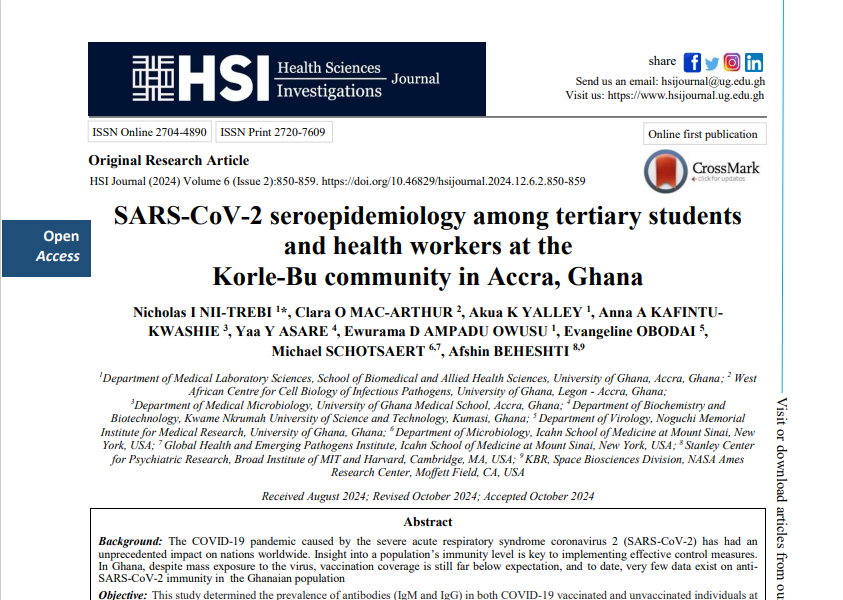SARS-CoV-2 seroepidemiology among tertiary students and health workers at the Korle-Bu community in Accra, Ghana
SARS-CoV-2 seroepidemiology among tertiary students and health workers at the Korle-Bu
Abstract
Background: The COVID 19 pandemic caused by the severe acute respiratory syndrome coronavirus 2 (SARS CoV 2) has had an unprecedented impact on nations worldwide. Insight into a population s immunity level is key to implement ing effective control measures. In Ghana, despite mass exposure to the virus, vaccination coverage is still far below expectation, and to date, very few data exist on anti SARS CoV 2 immunity in the Ghanaian population
Objective: This study determined the prevalence of antibodies (IgM and IgG) in both COVID-19 vaccinated and unvaccinated individuals at the Korle Bu Polyclinic and a cross-section of students of the School of Biomedical and Allied Health Sciences in Accra, Ghana..
Methods: A cross sectional study including 207 participants was conducted. Sera were obtained and tested for SARS CoV 2 specific IgG/IgM antibodies, while oropharyngeal swabs from IgM reactive individuals were tested for SARS CoV 2 RNA by RT PCR. Our stud y population comprised 207 individuals o f which 70 were vaccinated and 137 were unvaccinated.
Results: The total seropositivity in the population studied was 67·6% ( n = 140/207). The IgG seroprevalence was 60·9% ( n = 126/207). Evidence of seroconversion was observed in more of the vaccinated individuals (72·9%, n = 51/70) than in individuals who were not vaccinated (54·7%, n = 75/137). Thirteen (18·6%) of the vaccinated individuals were IgM reactive, while 19 (27.1%) w ere IgG unreactive. Seropositivity in healthcare workers was 63·2% ( n = 12/19), which was consistent with that observed for the entire study population. About 20% ( n = 9/46) of the individuals who tested positive for SARS CoV 2 specific IgM had detectable SARS CoV 2 by nucleic acid testing.
Conclusion: The results from this study show evidence of breakthrough infections and suggest a high exposure of the study population to SARS CoV 2, which might underscore a high prevalence of asymptomatic COVID 19 in Ghana despite the low hospitali s ation rate recorded at the time of sampling. This study also reaffirms the need for booster vaccination, reinforcement of COVID 19 control measures, and the need of broader serological studies in Ghana.


